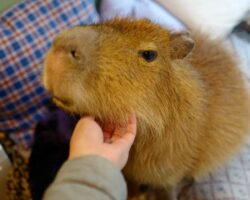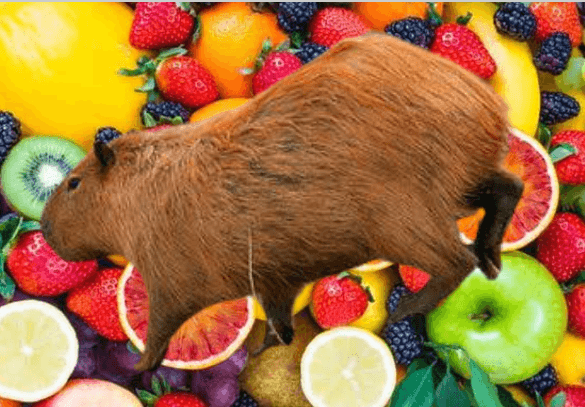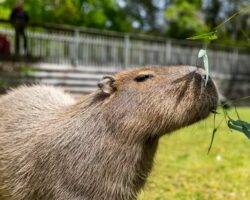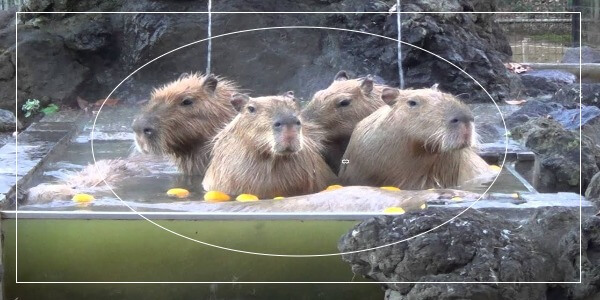If you have seen a capybara, chances are that you may have mistaken it for a guinea pig. Some people see the capybara more like a giant version of the guinea pig.
Capybaras and guinea pigs are both rodents and are closely related. Both rodents belong to Caviidae – the cavy family and share similar characteristics. They are herbivores, meaning their diet consists of greens, plants, grasses, and other vegetation.
Moreover, guinea pigs and capybara have similar-shaped bodies. Their eyes, ears, and nostrils are positioned close to the top of their heads. Also, they are friendly and social animals.
The major difference between guinea pigs and capybaras is that guinea pigs dislike water but capybaras love getting inside the water. Guinea pigs tend to avoid water and may get stressed out when they get wet but capybaras love spending time in water.
Capybaras are semi-aquatic animals, their webbed feet help them move in the water fast. These gigantic rodents tend to keep their dry skins wet and warm by staying in water for extended periods.
As the largest rodent in the world, the capybara weighs over 100 pounds, and some big ones get up to 140 to 150 pounds but even the largest guinea pigs don’t weigh up to 3 pounds.
Guinea pigs are the closest relatives of the capybara and it will be interesting to know about both rodents. In this article, we will uncover more facts about the guinea pigs and capybaras and discover how they relate to each other.
Are Capybaras Really Large Guinea Pigs?
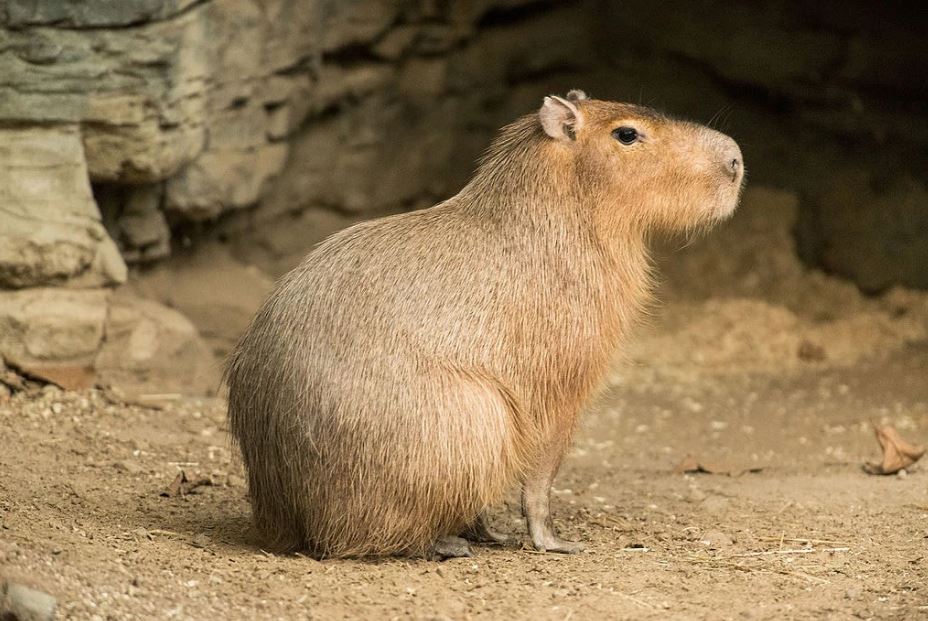
As mentioned, both guinea pigs and capybaras are rodents. Although they come from the same cavy family, they do have their similarities and differences.
Many believe or think that guinea pigs and capybaras are the same animal. Some people go as far as saying the capybara is a bigger species of guinea pig. This isn’t true. It is important that you understand that both rodents are different species, and as such, should be seen differently.
Capybaras, also referred to as water pigs or water hogs, are the largest rodents on the planet. They come from the wild and typically occupy grasslands with proximity to bodies of water and weigh up to 140 pounds.
Guinea pigs on the other hand weigh around 2 pounds. Unlike the capybara, the guinea pigs aren’t wild animals, they have a small size and are popular household pets.
Both the guinea pigs and capybaras are social animals but the latter appears to be more social and interactive than the former. While the capybara and guinea pig may share a lot of things in common, they should be seen as different species with different features and characteristics.
Both animals have different dietary needs and requirements. The capybara is known to be a herbivorous animal while the guinea pig is omnivorous.
Are Capybaras Related To Guinea Pigs?

The capybara is often compared with several animals, including guinea pigs, beavers, and actual pigs due to their overall appearance, diet, and lifestyle.
While the capybara shares some features of a guinea pig, it is actually different from a guinea pig. There are two types of capybara which are identified by their size. The two capybara species are the Hydrochoerus hydrochaeris, which is the larger capybara, and the Hydrochoerus isthmius, the smaller capybara.
The larger capybara is the biggest rodent in the world, weighing over 150 pounds and measuring up to 4.5 feet long. On the contrary, the smaller capybara typically weighs 60 pounds and measures 3 feet long. Both the larger and smaller capybara are bigger than the guinea pig.
Capybaras are known for their short webbed feet, long, thick brown hair, and long teeth. They do not have a tail. Their eyes, nostrils, and ears, are slightly positioned around the top of their head. The capybara’s face looks like a combination of that of a guinea pig and a beaver.
While the capybara is a skillful swimmer and spends a lot of its time in water, the guinea pig shies away from water bodies.
Where Are Capybara From and Where Do They Live?
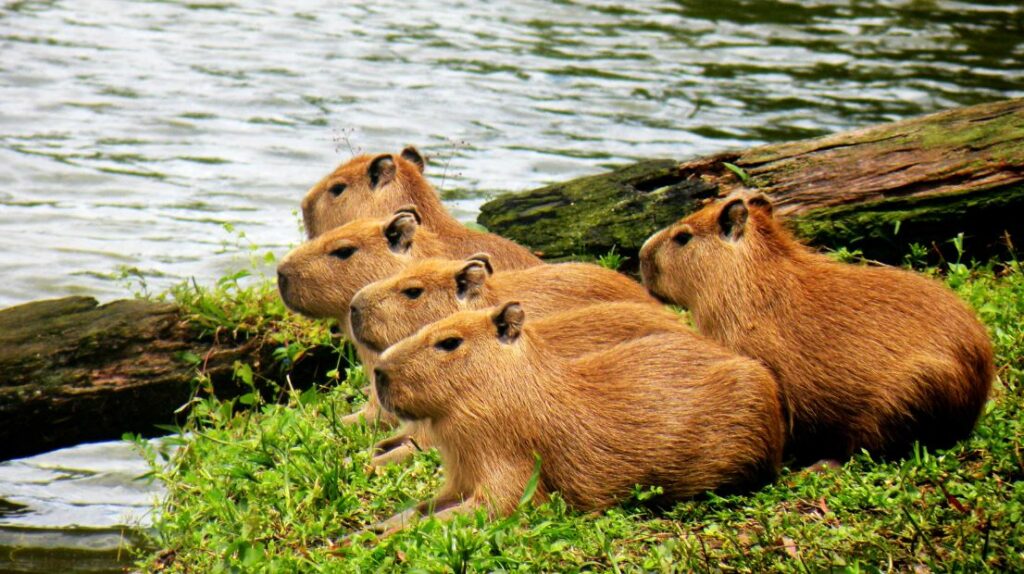
Capybaras come from South America and can be found near water bodies such as swamps, rivers, lakes, ponds, streams, marshes, and other riverine areas. These rodents also occupy grasslands on the east of the Andes mountains.
The capybara lives in the wild. Ideally, they love staying in places with close access to water. They have dry skin, which justifies their love for swimming. The capybara require water to chill, relax, and keep themselves hydrated.
One of the impressive abilities of the capybara is to stay underwater for several minutes. They typically stay submerged to hide from threats and predators or go in search of water plants. Spending a large chunk of their time in water helps them regulate their body temperature, relax, and keep cool, especially during the summer season.
Like guinea pigs, capybaras are peaceful and typically live in groups or herds of other capybaras. Each group consists of 10 or more members; sometimes, the herd can be as large as 40 members. This group is mixed with males and some females along with their young.

The dominant male capybara guides and defends the herd from attack while the females take care of the babies and young ones on board.
Another similar feature shared by the capybara and guinea pig is that both animals are active during the daytime but occasionally, may also sleep or relax during the day. Typically, they sleep and rest at night but may often stay awake for threats.
The males in every capybara group have a role to play in safeguarding the lives of other members of the herd. These rodents have means of communication and can converse with themselves using different sounds to alert and warn each other of threats and dangers.
Capybaras Vs Guinea Pigs: What Do They Eat?
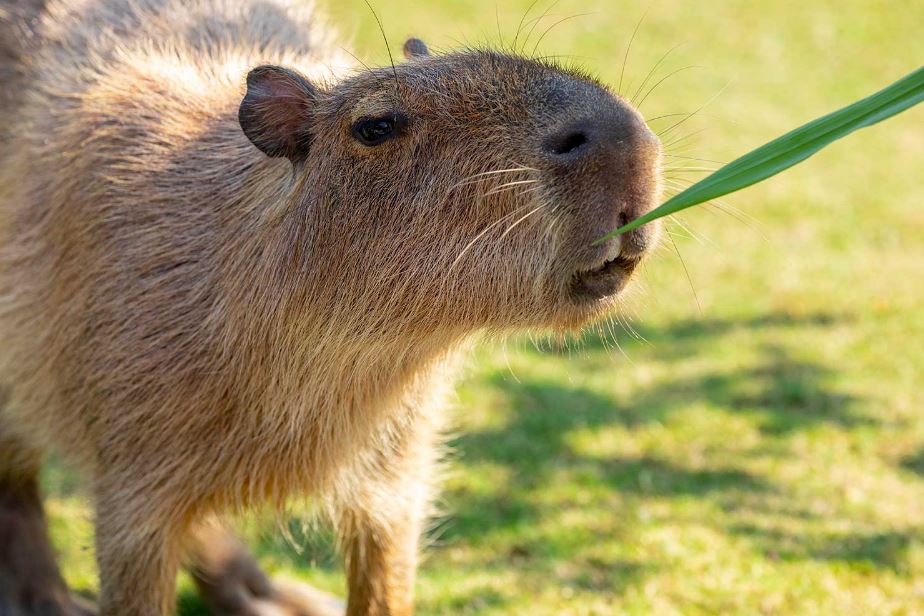
The capybara is a lover of water plants and fresh vegetation. These rodents eat grasses, plants, and vegetation from their home in Central and South American forests. They typically go underwater in search of aquatic plants.
A full-grown adult capybara can consume anywhere from 6 to 8 pounds of grass every day. They are provided with a variety of options to feed on during the wet or rainy season. During the dry season, the capybara will source alternative foods and eat any quality vegetation and fruit it can find, including melons, squash, reed, lemons, oranges, cucumber, banana, and others.
This rodent has the habit of eating their own poop. The capybara poops while in their pool and eats their own waste to get the full nutrients of their meals.
As you know, the capybara feeds on plants and grasses, which is hard to digest. So, eating their own poop helps them consume the food a second time and get more nutrients and benefits from it.

While the capybara is a voracious eater, the guinea pig doesn’t eat much. Like the capybara, the internal organs and body system of the guinea pig do not produce vitamin C. Nonetheless, these rodents require sufficient vitamin C in their diet.
Insufficient amount of vitamin C in their body will cause scurvy and other deficiencies, including delayed wound healing, a feeble immune system, and abnormal bone and tooth growth.
A guinea pig with a weakened immune system can fall sick to any illness and disease that comes its way. In such conditions, it is important to provide the animal with access to vitamin C foods and supplements. But before that, you can consider contacting a veterinarian to determine the right amount for the rodent.
Both capybaras and guinea pigs need to be well-fed to stay strong and healthy. A poor diet will cause issues such as bladder stones, gastrointestinal issues, dental disease, and obesity.
What Do Guinea Pigs Eat?
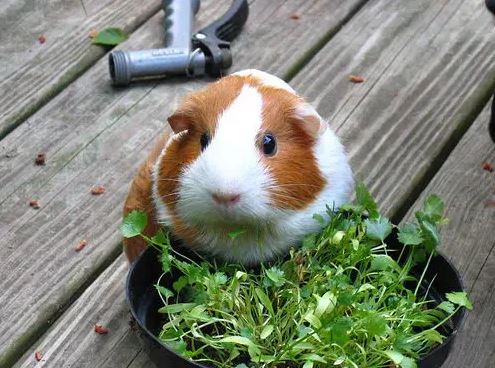
Grass hay is the most important diet for guinea pigs. Every guinea pig in captivity and the wild must have access to fresh, high-quality grass hay.
If you have a guinea pig in your custody, you can meet its dietary needs by providing it with a sufficient amount of grasshays. Ideally, more than 80% of the guinea pig’s diet must contain grass hay.
The secret of every healthy guinea pig is access to fresh grass hay. Undoubtedly, this rodent will find it difficult to survive without hay. They need hay to regulate their teeth growth and improve their digestive health.
Clover hay and alfalfa are rich in calcium and calories and can cause bladder stones, obesity, and abnormal calcification. They are often administered to pregnant cavys or young guinea pigs as it aids bone growth.
Adult guinea pigs over a year old can take timothy or orchard hay. Ideally, they also need a large supply of fresh grass hay daily.
Apart from grass hays, the guinea pig will relish other foods such as vegetables, brome hay, meadow, oats, pellets, vitamin C supplements, orchard hay, and water. Fruits can be provided to these rodents but with moderation, as they take less than 5% of the guinea pig’s diet.

Fruits should be provided occasionally and sparingly like once a day or three or four times a week as they are high in sugar. While feeding the guinea pig with fruits, cut out a piece or small portion of the fruit. Remember to introduce new fruits and vegetables from time to time as this helps prevent diarrhea.
If your pet guinea pig develops loose stool, consider reducing the amount of fruits, and feeding it with smaller portions instead. Some of the fruits eaten by the guinea pigs include:
- Kiwifruit.
- Strawberries.
- Cantaloupe.
- Apple.
- Pineapple.
Essentially, the guinea pig must be provided with fresh grass hays for the most part. Providing your pet guinea pig with high-quality hay helps the rodent combat gastrointestinal disorders and dental problems.
Like the capybara, the guinea pig has a set of ever-growing teeth. Since grasses are abrasive, eating enough grasses will help them wear down their growing teeth. Without this, their teeth can become overgrown or abscessed, which will make them experience difficulties in eating normally.
Fresh vegetables can be administered to the guinea pig but occasionally – like once a day.
When feeding the guinea pig with vegetables, ensure to provide it with a large supply of leafy greens such as cabbage, parsley, mustard or turnip greens, kale, red and green leaf lettuces, and romaine lettuce.
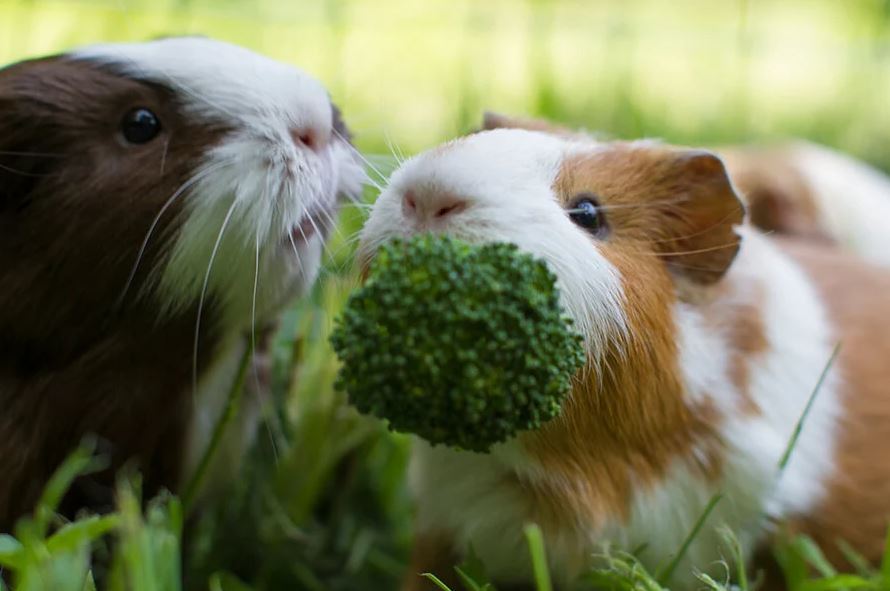
You can also consider vegetables such as broccoli, and red or green pepper as they contain high levels of vitamin C, which prevents scurvy in the animal. Providing your guinea pig with a daily treat of these vegetables won’t be a bad idea.
You can also include sweet potato, zucchini, and tomato once or two times a week. Whatever you do, make sure you mix and rotate the rodent’s diet by providing it with a variety of vegetation each day. This will also help prevent any diarrhea or any form of gastrointestinal discomfort.
Once you slowly introduce a new vegetable to the rodent, ensure it gets that vegetable multiple times a day. This way, your pet guinea pig will have a good balance of vitamins and minerals for quality health.
Some of the common vegetables given to guinea pigs include:
- Carrots.
- Cilantro.
- Tomatoes.
- Clover.
- Dandelion greens.
- Romaine lettuce.
- Leaf lettuce.
- Parsley.
While guinea pigs are not voracious eaters they require continuous eating due to their high metabolic rate. Since they are herbivores, they need a special diet and should not be fed with animal protein.
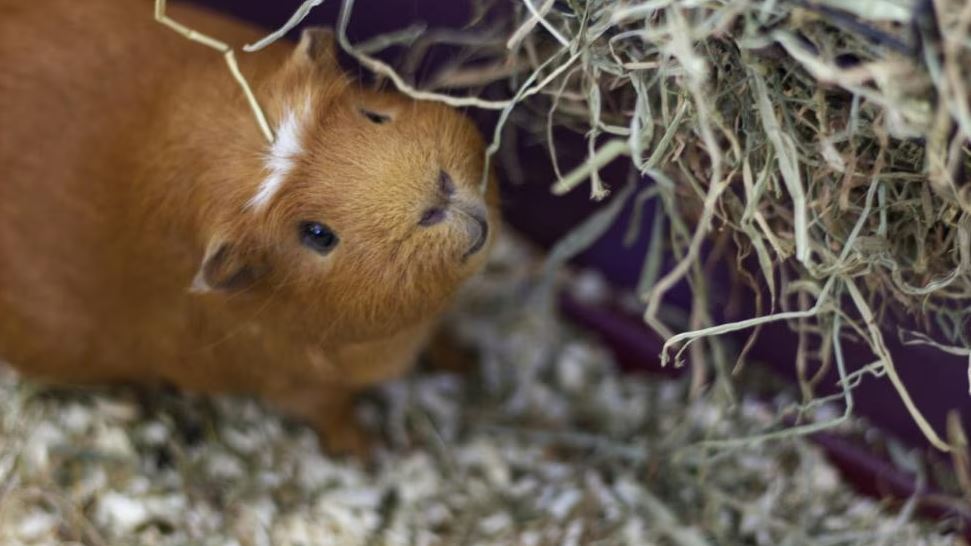
With varieties of food items on the market, guinea pig owners must be careful about what items they get for their pet and some of these products are produced and marketed with little or no scientific research. There are reports of some pet products being harmful to guinea pigs, so ensure you keep this in mind.
You can find pellet products for guinea pigs on the market, with some of them containing nuts and seeds. Just because a product is marketed for guinea pigs doesn’t always mean it is good for the rodent.
Guinea pigs should never be fed with seeds or nuts. If you will be feeding the animal with pellets, ensure it takes up a small portion of its diet.
When choosing commercial food for your guinea pigs, consider timothy-based vitamin C-fortified pellets that have no seeds or dried fruit in them. Ideally, 1/8 cup of pellets daily along with enough hay and fresh vegetables will be okay for the rodent.
Seeing the fast degradation of vitamin C, it is crucial to provide your guinea pig with a daily supply of vitamin C-rich fruits and vegetables. Don’t buy in bulk but in smaller potions to improve the impact of the added vitamin C, as it oxidizes quickly when open.
Are Capybaras Endangered?
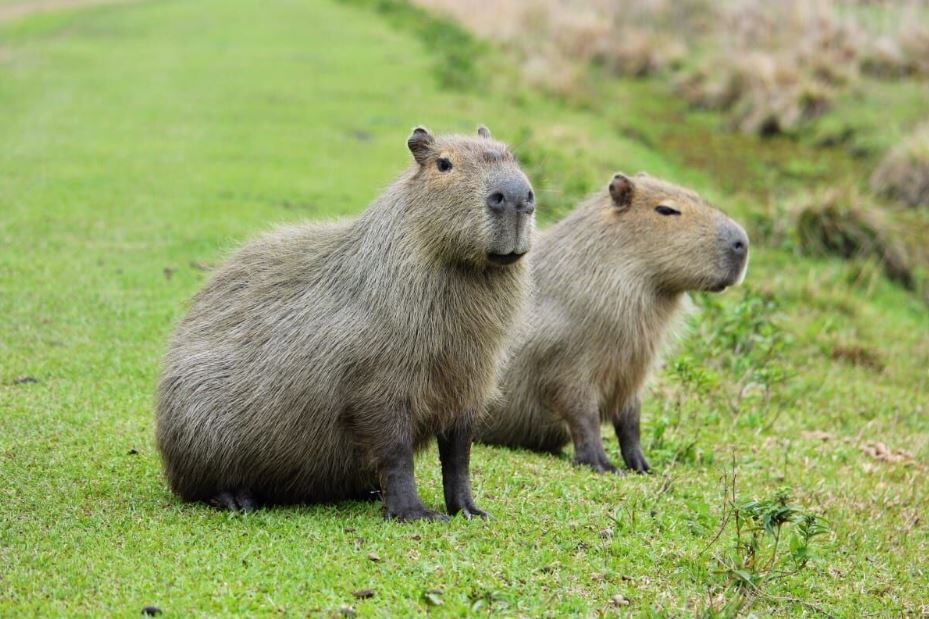
Capybaras face a lot of threats, both from humans and other animals in the wild. You may begin to think whether these rodents are endangered. At the moment, capybaras have a stable population and are not endangered.
However, these rodents face a lot of attacks and challenges in the wild, as they are threatened by poaching and deforestation. Wild animals such as ocelots, pumas, snakes, eagles, and jaguars hunt capybara for food.
Likewise, human usually hunts these animals for their meat as well as their hides, which will be used to produce belts, bags, and other kinds of leather goods.
To preserve and maintain the capybara population, hunters must stop killing capybaras and more shelter homes must be provided for the rodent.
Conclusion
Guinea pigs are capybaras and are cool pets to have in your home. Despite their similarities, both animals are not in competition with each other. You can find pictures of capybaras and guinea pigs hanging out together and co-existing peacefully.
While the capybara is a wild animal, it is friendly and social. Guinea pigs and capybaras have different needs, so taking care of both rodents would be different. If you plan to keep both animals, it is important to do your research to know which is ideal for you to keep based on their dietary needs and lifestyle.

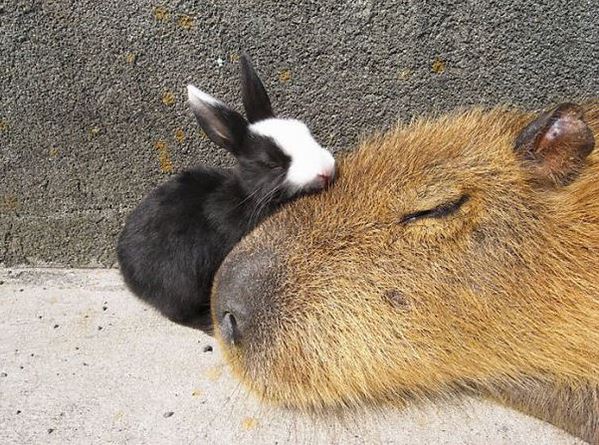
![Capybara Meat And Its Culinary Uses - [Every You Should Know] Capybara Meat & Culinary Uses](https://capybaratips.com/wp-content/uploads/2023/03/Capybara-meat-250x200.webp)
